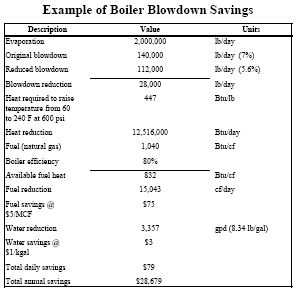Boilers
Commercial, industrial, and institutional hot water heating methods vary significantly. Some older buildings use water heated by boilers (primarily fueled by natural gas or fuel oil) and passed through a heat exchanger to cool water to 140 degrees Fahrenheit. Boilers may consume large quantities of both water and energy in commercial, industrial, and institutional applications.
Opportunities for water savings in boilers is not significant compared to other areas (such as end use fixtures), but opportunities do exist. The best place to look for savings is in the blowdown, or water drained from the boiler to reduce impurities, through optimizing this process. Blowdown typically represents about 5 to 7 percent of water use by boilers. For example, about one fifth of boiler blowdown can be saved by changing from manually adjusted to automatically controlled continuous blowdown in an average application. If blowdown is assumed to be 7 percent, then a 20 percent reduction would yield a savings of about 1.4 percent of the total water usage. While the water savings are small, the energy savings are important because every gallon of water saved will not have to be reheated.

WATERGY: A Water and Energy Conservation Model for Federal Facilities
